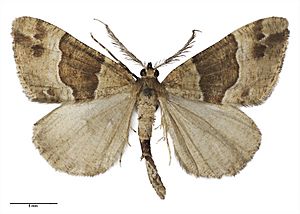Pseudocoremia facts for kids
Quick facts for kids Pseudocoremia |
|
|---|---|
 |
|
| Male holotype specimen of Pseudocoremia insignita | |
| Scientific classification | |
| Kingdom: | |
| Phylum: | |
| Class: | |
| Order: | |
| Family: | |
| Genus: |
Pseudocoremia
|
Pseudocoremia is a group of moths. These moths are part of the family called Geometridae. You can only find Pseudocoremia moths in New Zealand. This means they are endemic to that country.
Contents
What are Geometer Moths?
Pseudocoremia moths belong to the Geometridae family. This is a very large family of moths. They are often called "geometer moths" or "loopers." This name comes from how their caterpillars move.
How Geometer Moths Move
Geometer moth caterpillars have a special way of moving. They have fewer legs in the middle of their bodies. To move, they pull their back legs up to their front legs. This makes their body form a loop. Then, they stretch their front legs forward. It looks like they are measuring the ground. This is why they are called "earth-measurers" (which is what "geometer" means).
Where Pseudocoremia Moths Live
As mentioned, Pseudocoremia moths are only found in New Zealand. This island nation has many unique plants and animals. These moths have adapted to live in New Zealand's special environments.
New Zealand's Unique Habitats
New Zealand has diverse landscapes. These include forests, mountains, and coastal areas. Different species of Pseudocoremia might prefer different types of habitats. They often blend in with their surroundings. This helps them hide from predators.
Appearance of Pseudocoremia Moths
Like most moths, Pseudocoremia moths have wings covered in tiny scales. Their colors and patterns can vary. Many moths in the Geometridae family are dull-colored. This helps them camouflage against tree bark or leaves.
Camouflage and Survival
Camouflage is very important for moths. It helps them avoid being seen by birds and other animals. Some Pseudocoremia species might have patterns that look like lichen or bark. This makes them almost invisible when they rest during the day.
The Life Cycle of a Moth
All moths go through a process called complete metamorphosis. This means they have four main life stages. Pseudocoremia moths follow this same pattern.
Four Stages of Life
- Egg: The life cycle begins when an adult female moth lays tiny eggs. She usually places them on plants.
- Larva (Caterpillar): The egg hatches into a larva, which is a caterpillar. This is the feeding stage. The caterpillar eats a lot of leaves and grows quickly. Pseudocoremia caterpillars are the "loopers" we talked about.
- Pupa: After growing enough, the caterpillar forms a pupa. This is a resting stage. Inside the pupa, the caterpillar transforms into an adult moth.
- Adult: Finally, the adult moth emerges from the pupa. The adult's main job is to reproduce. They lay eggs to start the cycle all over again.
What Moths Eat
The diet of Pseudocoremia moths depends on their life stage. Caterpillars and adult moths eat different things.
Caterpillar Diet
Pseudocoremia caterpillars are herbivores. This means they eat plants. They munch on leaves from specific types of plants. These plants are called "host plants." The type of host plant can vary between different Pseudocoremia species.
Adult Moth Diet
Most adult moths, including Pseudocoremia, do not eat solid food. Many adult moths drink nectar from flowers. This gives them energy for flying and reproduction. Some moths might not feed at all as adults. They rely on the energy stored from their caterpillar stage.
Importance in the Ecosystem
Moths like Pseudocoremia play a role in their ecosystem. They are part of the food web.
Moths as Food
Moth caterpillars and adults are a food source for many animals. Birds, bats, and other insects eat them. This makes them an important link in the food chain.
Pollination
While not as famous as bees, many moths are also pollinators. As they visit flowers for nectar, they can carry pollen from one flower to another. This helps plants reproduce.

